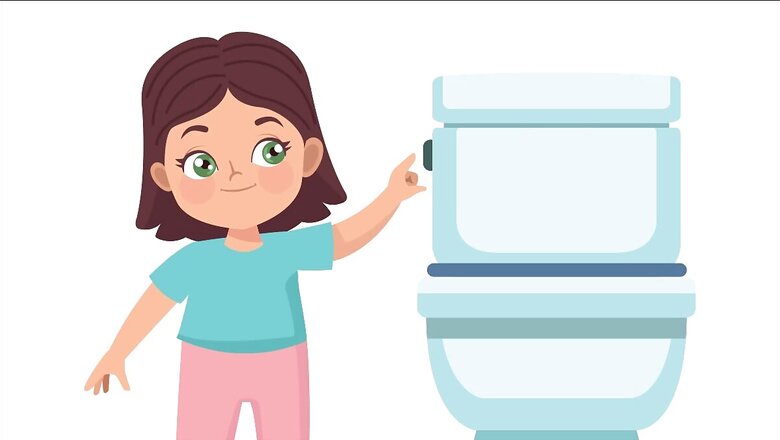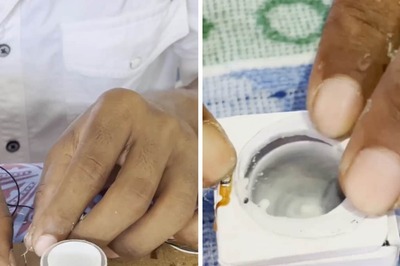
views
Nearly everyone can remember their first scary movie. With a little thought, they can also pinpoint the weird little fear, phobia, or discomfort that arose from that scary movie. Even though the logical mind knows that the fear comes from a silly movie, the fear lingers, because of the negative associations our minds created way back when.
Children are impressionable and sensitive to their surroundings. They learn from their experiences and form associations that can influence their behaviour and attitudes for a lifetime. While this is true of several areas in life, one area where this is particularly evident is our toilet habits.
Toilets are essential for health and hygiene, but they can also be sources of anxiety, discomfort, and embarrassment for children. Many factors can affect how children perceive and interact with toilets, such as the cleanliness, design, accessibility, privacy, and safety of the facilities.
Clean and well-maintained toilets can have a positive psychological impact on children, creating associations that foster confidence, comfort, and dignity. In contrast, dirty and neglected toilets can have a negative psychological impact on children, creating associations that trigger fear, disgust, and shame.
What are Positive Associations?
Positive associations are mental links that we form between stimuli and outcomes, such as rewards or punishments. They influence our behaviour by making us more likely to repeat actions that lead to positive outcomes (rewards), and avoid actions that lead to negative outcomes (punishments). For example, if we associate eating vegetables with feeling healthy and happy, we are more likely to eat them regularly.
Positive associations are especially important for children, who are still developing their cognitive and emotional skills. By creating positive associations with hygiene habits, such as using toilets and washing hands, we can help children form healthy routines that will benefit them throughout their lives.
Children are constantly learning from their environment and making mental connections and associations. They use these associations to understand the world and make decisions. When a child sees a dirty toilet, they usually associate it with germs, disease, or discomfort, and avoid using it. On the other hand, if they see a clean toilet, they usually associate it with safety, comfort, or pleasure, and use it willingly.
Fostering Hygiene Practices: The Role of Positive Toilet Experiences
One of the ways to create positive associations with hygiene habits is to provide children with positive toilet experiences. This means creating welcoming and child-friendly restroom environments that make children feel comfortable and happy to use them.
Some of the factors that contribute to positive toilet experiences are:
Cleanliness: A clean toilet is not only hygienic, but also appealing and inviting. It shows respect and care for the users, and reduces the risk of infections and diseases.
Aesthetics: A pleasant toilet environment can include elements such as bright colours, pictures, stickers, or toys that make it more attractive and fun for children. It can also include natural elements such as plants or flowers that create a sense of freshness and harmony.
Accessibility: A child-friendly toilet should be easy to access and use for children of different ages, sizes, and abilities. It should have appropriate facilities such as doors, locks, seats, handles, flushes, sinks, soap, towels, or paper that suit the needs and preferences of children.
Privacy: A child-friendly toilet should provide enough privacy for children to feel safe and comfortable. It should have adequate partitions, curtains, or doors that prevent unwanted exposure or intrusion.
Safety: A child-friendly toilet should be free from hazards such as sharp objects, slippery floors, broken fixtures, or pests that could harm or scare children. It should also have adequate lighting, ventilation, drainage, and security measures that ensure a safe and healthy environment.
By providing these features in toilets, we make it easier for children to use toilets, practise proper toilet hygiene, and feel safe and confident when doing so.
Learning from Education Initiatives
Several education initiatives have successfully used positive associations to promote hygiene practices among children. These initiatives have incorporated positive toilet experiences into school curricula and activities, and have involved collaboration between educators, parents, and caregivers.
Some examples of these initiatives are:
The Fit for School program in the Philippines uses a group handwashing approach that makes hand washing fun and social for children. The program provides schools with clean water sources, soap dispensers, handwashing stations, and colourful posters that remind children to wash their hands before meals and after using the toilet. The program also trains teachers to integrate hygiene education into their lessons and monitor the handwashing behaviour of students.
The WASH in Schools program in Nepal uses a child-to-child approach that empowers children to become agents of change in their communities. The program provides schools with clean toilets, water filters, soap bars, menstrual hygiene kits, and waste bins that make hygiene accessible and convenient for children. The program also trains students to form WASH clubs that conduct peer education sessions, awareness campaigns, school audits, and advocacy events on hygiene issues.
Harpic, India’s leading brand in the lavatory care segment, has also been a part of several outreach programs towards schools and school children. Harpic has partnered with News18 in the Mission Swachhta aur Paani Initiative, which has, for 3 years now, championed the cause of inclusive sanitation, equality for all genders, abilities, castes and classes and the strong belief that clean toilets are a shared responsibility.
Under the aegis of Mission Swachhta aur Paani, Harpic partnered with Sesame Workshop India, an educational non-profit, to promote positive sanitation, hygiene knowledge and behaviours among children and families through schools and communities, engaging with 17.5 million children across India.
As parents, there are many ways that you can make your own toilet and the one at school easier for your child to use and enjoy. Mission Swachhta aur Paani is a wellspring of information on all toilet hygiene and toilet access topics, and you can use the information contained here to make your case with the local school board, your social club, building society, local park association and any other space where children use the toilet.
Join us here, and be a part of the movement towards a Swachh and Swasth Bharat.


















Comments
0 comment